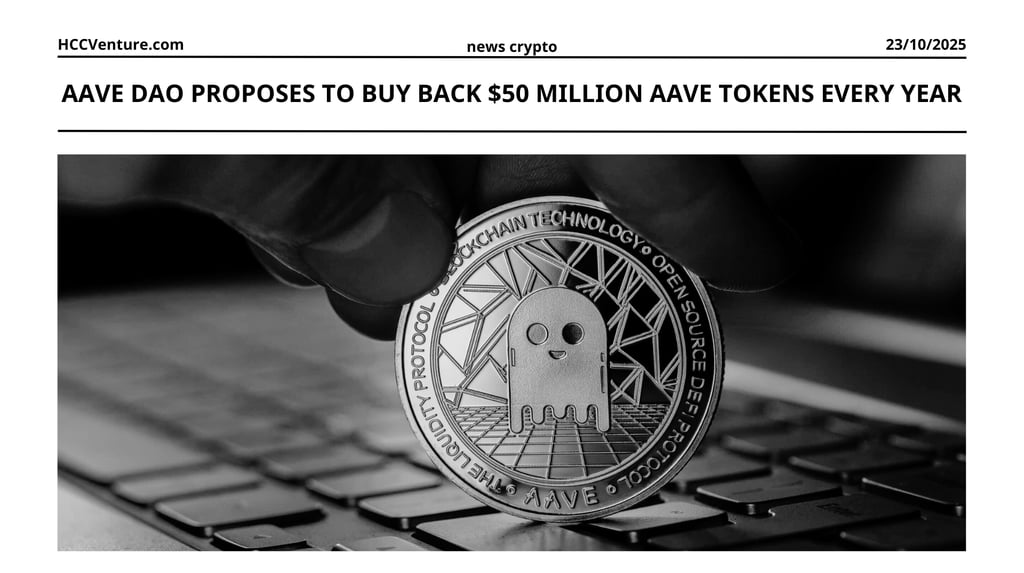Aave DAO buys back $50 million in AAVE tokens each year
Aave DAO has sparked a new wave of optimism in the DeFi lending platform with a governance proposal to institutionalize an annual $50 million AAVE token buyback program, funded directly from protocol revenue.
10/23/20252 min read


From ARFC to Aavenomics Overhaul
Aave’s Request for Comments (ARFC), filed by ACI founder Marc Zeller, proposes share buybacks as a core pillar of tokenomics, allocating up to $50 million annually from Aave’s soaring revenue — nearly $500 million generated in the past year alone.
The weekly execution, managed by the Aave Finance Committee (AFC) and TokenLogic, will adjust according to liquidity and market conditions, ensuring “prudent financial strategies” without overburdening the budget.
Excess funds will be funneled into ecosystem reserves to fund funding and safety modules like a new “Umbrella” insurance layer that mitigates the risk of default through automated smart contracts. Zeller, a DeFi advocate, called this “the most important proposal in Aave’s history,” arguing that it turns idle surplus into “higher returns for stakers” and sustains buying pressure.
The initiative builds on Aave’s previous buyback success—reducing circulating supply by 2% starting in 2024—while also providing flexibility to leverage BTC/ETH reserves for yield-earning or growth collateralized debt. Voting will begin after the snapshot, with approval expected in November, synchronizing with the Aave V4 testnet rollout. This comes amid a strong recovery in DeFi fees: Aave ranks second in monthly fees at $600 million, behind only Uniswap, according to The Block Research. Similar programs at Raydium and Pendle have stabilized token prices by 15-20%, demonstrating AAVE’s growth potential.
AAVE Buyback Cycle Structure
Proposed allocation of $50 million annually for AAVE token buybacks, funded from protocol revenue rather than external funding. Proposed weekly buyback intervals range from $250,000 to $1.75 million, with flexibility to scale based on market conditions, liquidity, and financial situation.
Implementation will be overseen by AFC, in coordination with TokenLogic, and follow the “Aave Request for Comments (ARFC)” process, followed by Snapshot voting and on-chain confirmation.
The stated goals are to accumulate value for token holders, optimize the deployment of financial capital, and minimize volatility or downside risk through systematic demand.
An influential community
By integrating buybacks into its protocol design, Aave moves from reactive token management to a strategic, periodic capital policy. This brings DeFi tokenomics closer to corporate treasury operations in traditional finance — where buybacks are used to accumulate value and signal.
With this initiative, Aave could differentiate itself in the crowded DeFi ecosystem by offering not just a lending platform but a financially sophisticated protocol that aligns treasury operations with the interests of token holders. This could attract deeper institutional capital and confidence in AAVE as a “governance plus value” asset.
The timing is no coincidence. The buyback proposal comes as the community is looking forward to the launch of Aave v4, which will introduce modular architecture, cross-chain liquidity centers, and improved capital efficiency. The buyback commitment positions the upcoming upgrade as not just a technical milestone, but also a financial one.
Disclaimer: The information presented in this article is the author's personal opinion in the cryptocurrency field. It is not intended to be financial or investment advice. Any investment decision should be based on careful consideration of your personal portfolio and risk tolerance. The views expressed in this article do not represent the official position of the platform. We recommend that readers conduct their own research and consult with a professional before making any investment decisions.
Explore HCCVenture group
HCCVenture © 2023. All rights reserved.


Connect with us
Popular content
Contact to us
E-mail : holdcoincventure_contact@hccventure.com
Register : https://linktr.ee/holdcoincventure
Disclaimer: The information on this website is for informational purposes only and should not be considered investment advice. We are not responsible for any risks or losses arising from investment decisions based on the content here.


TERMS AND CONDITIONS • CUSTOMER PROTECTION POLICY
ANALYTICAL AND NEWS CONTENT IS COMPILED AND PROVIDED BY EXPERTS IN THE FIELD OF DIGITAL FINANCE AND BLOCKCHAIN BELONGING TO HCCVENTURE ORGANIZATION, INCLUDING OWNERSHIP OF THE CONTENT.
RESPONSIBLE FOR MANAGING ALL CONTENT AND ANALYSIS: HCCVENTURE FOUNDER - TRUONG MINH HUY
Read warnings about scams and phishing emails — REPORT A PROBLEM WITH OUR SITE.
